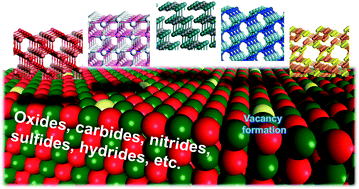Understanding and controlling the formation of surface anion vacancies for catalytic applications
Abstract
Defects are important as they often govern the chemical and physical properties of solid materials. Surface defect sites, such as anion vacancies, most commonly oxygen vacancies for oxides, are well-known reaction sites in heterogeneous catalysis. Although the importance of defects at catalyst surfaces is well recognized and commonly accepted by the catalysis community, details of their atomic and electronic structures are lacking, which is largely because identifying surface defects is challenging and mostly beyond the resolution of currently available experimental techniques. Moreover, the complexities of the geometrical and electronic structures of surfaces make computational investigations difficult. Presently, studying an individual material requires substantial amounts of experimental and calculation time/cost; hence, few comprehensive studies have been performed. In this Perspective, we summarize our recent systematic computational efforts using density functional theory to calculate surface anion vacancy formation energies (Evac) as important descriptors of catalytic performance. The systems explored include binary oxides, complex oxides, carbides, nitrides, sulfides, hydrides, and oxides with supported metals. Exotic surfaces with high-index orientations were also considered. In addition, we studied relationships between physicochemical properties and surface anion Evac values in order to rationalize the properties of compounds/surfaces and the support metals and to provide a predictive tool. The definitive goal of our work was to gain fundamental knowledge of the factors determining surface defect formation and ultimately catalytic activity/selectivity so that ideal catalytic materials/surfaces can be designed and manipulated in a highly precise manner.

- This article is part of the themed collection: 10th Anniversary Perspectives


 Please wait while we load your content...
Please wait while we load your content...